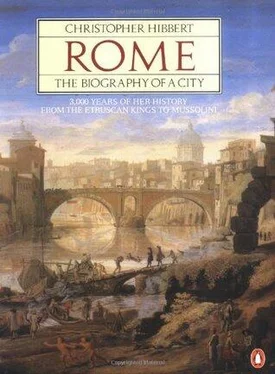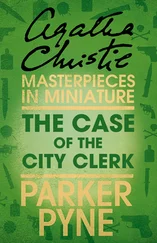Christopher Hibbert - Rome. The Biography of the City
Здесь есть возможность читать онлайн «Christopher Hibbert - Rome. The Biography of the City» весь текст электронной книги совершенно бесплатно (целиком полную версию без сокращений). В некоторых случаях можно слушать аудио, скачать через торрент в формате fb2 и присутствует краткое содержание. Жанр: Культурология, Искусство и Дизайн, на английском языке. Описание произведения, (предисловие) а так же отзывы посетителей доступны на портале библиотеки ЛибКат.
- Название:Rome. The Biography of the City
- Автор:
- Жанр:
- Год:неизвестен
- ISBN:нет данных
- Рейтинг книги:3 / 5. Голосов: 1
-
Избранное:Добавить в избранное
- Отзывы:
-
Ваша оценка:
- 60
- 1
- 2
- 3
- 4
- 5
Rome. The Biography of the City: краткое содержание, описание и аннотация
Предлагаем к чтению аннотацию, описание, краткое содержание или предисловие (зависит от того, что написал сам автор книги «Rome. The Biography of the City»). Если вы не нашли необходимую информацию о книге — напишите в комментариях, мы постараемся отыскать её.
Rome. The Biography of the City — читать онлайн бесплатно полную книгу (весь текст) целиком
Ниже представлен текст книги, разбитый по страницам. Система сохранения места последней прочитанной страницы, позволяет с удобством читать онлайн бесплатно книгу «Rome. The Biography of the City», без необходимости каждый раз заново искать на чём Вы остановились. Поставьте закладку, и сможете в любой момент перейти на страницу, на которой закончили чтение.
Интервал:
Закладка:
16. The main Roman Aqueducts in the time of Constantine were as follows:The Acqua Appia was completed in 312 B.C. by the Consul Appius Claudius from springs east of Rome.The Acqua Anius Vetus (272 B.C.) brought spring water from the upper Anio valley.The Acqua Marcia (144 B.C.) was built by the Praetor Marcius to supply the Capitol, Caelian and Aventine hills. Its arches later carried the waters of the Tepula (137 B.C.) and the Julia (33 B.C.) aqueducts.The Acqua Virgo (19 B.C.) was built by Agrippa for
Name
Description and Location
Date
*Pons Sublicius
This was the most ancient of the bridges. Built in Rome close to the FORUM BOARIUM, it was made entirely of wood and was the bridge of the Horatian legend.
The time of the kings
Pons Salarius
This carried the Via Salaria across the Aniene River which joins the Tiber just north of Rome. It was destroyed by the Goths under Totila, rebuilt by Narses and demolished again by the French in 1867 to delay Garibaldi. It was restored in 1874 and enlarged in 1930. It is now the Ponte Salario.
Some time before 361 B.C.
Pons Aemilius
Built by the Censors M. Aemilius Lepidus and M. Fulvius Nobilior and finished by the Censors, P. Cornelius Scipio Aemilianus and L. Mummius, the bridge was supported on stone piers. It collapsed twice when Gregory XIII had it rebuilt in about 575. It collapsed again in 1598, after which it remained broken and was known as the PONTE ROTTO. A fragment survives just above the present Ponte Palatino.
179–142 B.C.
Pons Milvius
Built or rebuilt by the Censor Marcus Aemilius Scaurus, this bridge was restored by Pope Nicholas V (1447–55) and again in 1805 by Valadier for Pope Pius VII. It was again restored by Pius IX after having been partially destroyed in 1849 when Garibaldi's forces were retreating from the French. It is now the PONTE MILVIO.
End of second century B.C.
Pons Fabricius
Built by the Consul L. Fabricius, it is the oldest bridge in use in Rome today. It joins the left bank of the Tiber to the island. It is now known as the PONTE FABRICIO.
62 B.C.
Pons Cestius
Built from the right bank of the Tiber to the island, it is now the PONTE CESTO.
46 B.C.
*Pons Agrippa
Near the PONTE SISTO (Pons Aurelianus, below).
Reign of Augustus
Pons Neronianus
Built by Nero near the present Ponte Vittorio Emanuele, it was later called Triumphal's and Vaticanus. It fell into decay before the year 403.
A.D. 54–68
Pons Aelius
Built by Hadrian to connect his mausoleum to the city, it is now called Ponte S. Angelo. Its architect was Demetrianus. The bridge is still standing but was altered by the addition of two arches in 1688, one at either end. Pope Clement IX (1667–9) commissioned Bernini to decorate it with statues of angels.
A.D. 136
Pons Aurelianus
This bridge was built by Marcus Aurelius. Destroyed in 792, it was replaced by Pope Sixtus IV in 1474. The first papal bridge to be built in Rome, it came to be known as the PONTE SISTO.
A.D. 161–80
his baths. Its water was mostly carried underground from springs on Lucullus's estate. Pope Nicholas V repaired the channel of the aqueduct, which had remained blocked for eight centuries, and had the final reservoir constructed in 1453. It was the only aqueduct bringing water to the city in the fifteenth century. Further restoration was carried out by Urban VIII. This is the aqueduct that feeds the FONTANA DI TREVI. Its name is supposed to commemorate a young girl who led some thirsty Roman soldiers to the springs.
The Acqua Claudia and Anius Novus were started by Caligula (A.D. 38) and finished by Claudius (A.D. 52). The Acqua Claudia, whose fine arches are a feature of the landscape of the Roman Campagna, carried water to Rome from Subiaco, forty-five miles away. The two aqueducts were joined three miles from Rome.
The Acqua Neroniana was built by Nero to take some of the water from the Claudian aqueduct directly to his palace on the Palatine.
The Acqua Trajana was built by Trajan in A.D. 109 to carry water, mostly underground, to the Janiculum.
The Acqua Alexandriana was built about A.D. 226. It was the last of the imperial Roman aqueducts.
In addition there were no less than ten other aqueducts which together have been estimated to have provided Rome with 350,000,000 gallons daily. The aqueducts suffered damage during the barbarian invasions but were mostly destroyed by neglect in the Middle Ages.
17. The BASILICA OF ST PAUL OUTSIDE THE WALLS, built by Constantine and consecrated by Pope Sylvester in 324, was erected on the spot where, it was believed, the body of the Apostle had been buried by his disciple, Timothy, soon after his execution. This church was destroyed in the time of the Emperor Theodosius in 386 and a much larger basilica, with nave and double aisles and containing eighty columns, was built to replace it and was consecrated in 390 by Pope Siricius, though not completed till 395. In the early seventh century, two monasteries were attached to the basilica and handed over to the Benedictines when united. To protect the church and the monastery from pirate raids, Pope John VIII (d. 882) built a defensive wall round the church and neighbouring buildings. In the course of later centuries the basilica was enriched with works of art by Pietro Cavallini, Arnolfo di Cambio, the Vassallettos, Benozzo Gozzoli and Antoniazzo Romano. A new campanile was added in 1348. In 1823 the basilica was largely destroyed by fire, but work started almost immediately on a new church modelled on the old one. This was consecrated in 1850 by Pius IX. The beautiful early-thirteenth-century cloister, with its lovely mosaic-encrusted columns of different shapes and styles, which escaped destruction by fire, is perhaps by Pietro Vassalletto.
18. The ancient titular church of S. LORENZO IN DAMASO was founded by Pope Damasus (366–84) on the site of his house, though the present edifice dates only from the time of the PALAZZO DELLA CANCELLERIA into which it was incorporated by Bramante for Cardinal Riario. After being used as a stables by French troops during the Napoleonic occupation of Rome, the church was restored, first by Valadier who provided the façade and more completely in 1880 by Vespignani. A fire in 1944 again caused damage which led to further restoration under Pius XII. Two strong supporters of the papacy have their tombs in this church: Cardinal Scarampo who, when in charge of a papal flotilla, defeated the Turks at Mytilene in 1457, and Pellegrino Rossi, the last of Pius IX's Prime Ministers (see Chapter 15).
19. According to legend, the original church of s. PUDENZIANA was built over the site of the house in which St Peter was said, on no verifiable authority, to have lived for several years, converting its owner, the Senator Q. Cornelius Pudens, and his daughters, Pudenziana and Prassede, who were both diligent in gathering and burying the bones of martyrs. An oratory was certainly built on this spot in the reign of Pope Pius I ( c . 140- c . 155). It must, therefore, have been one of the earliest church buildings in Rome. In A.D. 384, when the church was restored or rebuilt by Pope Siricius, it was called for the first time Ecclesia Pudentiana. Further restoration followed under Popes Hadrian I (d. 795) and Gregory VII (d. 1085). The final reconstruction, which left the church as we see it today, was carried out in 1589 by Alessandro Volterra for Cardinal Caetani. The façade was restored by the only one of Napoleon's family to follow his advice and become a Prince of the Church, Cardinal Luciano Bonaparte, who bore a striking resemblance to the Emperor but was charming, shy and given to good works. The fourth-century mosaic in the apse depicting the Apostles gathered round Christ and looking like Roman senators is an evocation of classical Roman art without the addition of Eastern influences. According to Professor Richard Krautheimer it is ‘the earliest figural representation to survive in, and presumably one of the first to be designed for, a Roman church’.
Читать дальшеИнтервал:
Закладка:
Похожие книги на «Rome. The Biography of the City»
Представляем Вашему вниманию похожие книги на «Rome. The Biography of the City» списком для выбора. Мы отобрали схожую по названию и смыслу литературу в надежде предоставить читателям больше вариантов отыскать новые, интересные, ещё непрочитанные произведения.
Обсуждение, отзывы о книге «Rome. The Biography of the City» и просто собственные мнения читателей. Оставьте ваши комментарии, напишите, что Вы думаете о произведении, его смысле или главных героях. Укажите что конкретно понравилось, а что нет, и почему Вы так считаете.












